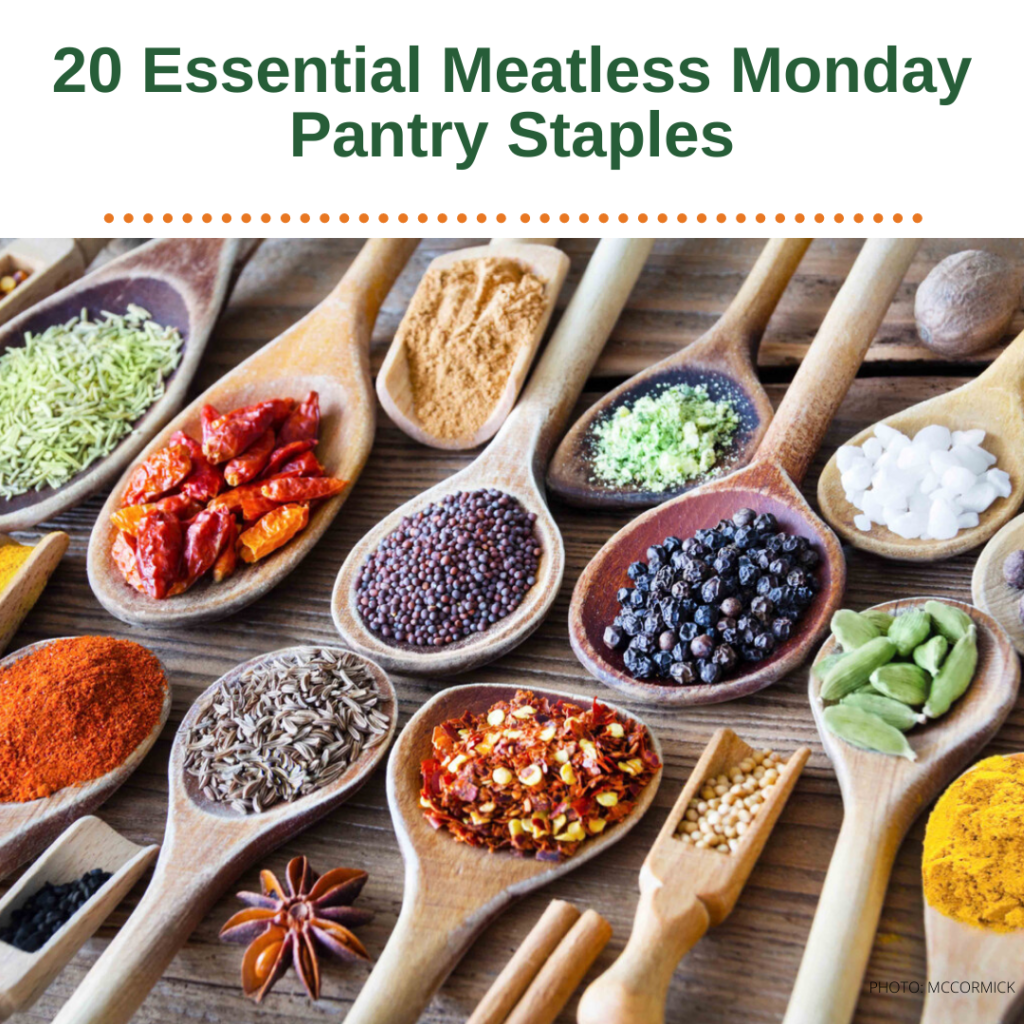How Many of These 20 Essential Meatless Monday Ingredients Are in Your Pantry?
A properly-stocked pantry is essential for creating delicious plant-based dishes on the fly.
But what does “properly-stocked” really mean?
Sure, you need the basics — olive oil, white flour, rice, pasta, etc., but there are some additional ingredients that you should consider adding to your collection. Alternative flours, “exotic” spices, seeds, nut butters, beans (butter beans will change your life), broths, and grains can all add extra levels of depth, dimension, and texture to any variety of plant-based dishes.
You’ll likely be familiar with many of the items on this list, but there are also a few lesser known ingredients — agar-agar, tahini, nutritional yeast, etc. — which can be used to replace many traditional animal-based ingredients. So, grab a paper and pen, and make sure these items are on next week’s shopping list.
Agar-Agar
The perfect vegan gelatin replacement for your puddings, jellies, or gelées, agar-agar flakes are derived from seaweed and function similarly to animal-based gelatins.
Alternative Flours
We’re not talking your run of the mill (went there) all-purpose, bleached white flour. Play around with some alternative flours like almond, chickpea, rice, or buckwheat. Many alternative flours are also gluten-free.
Beans (canned)
Explore the world of beans, and reap the benefits of a healthy, satisfying plant-based protein. Lentils, black beans, butter beans, kidney beans, chickpeas — doesn’t matter; they’re all easy to use, shelf-stable, healthy, and inexpensive.
Broth
A box of vegetable broth is a staple of any kitchen, but you can expand your soup selection by adding some “chick’n” bouillon cubes to your pantry.
Coconut Oil
A shelf-stable saturated fat, coconut oil is a healthy alternative to other vegetable oils. In most cases it can be substituted 1:1 for other oils and butters. It’s got a laundry list of benefits that range from weight loss to improved cognitive functioning.
Chocolate
All vegetables and no sweets make everyone hangry. A little bit of chocolate can go a long way in baking as well as a post-dinner night cap. If you’re feeling adventurous try some exotic bars that contain a higher percentage of cacao.
Diced Tomatoes (canned)
Take a simple stew, stir-fry, or sauce to the next level with a can of diced tomatoes. They’re every home cook’s secret weapon. Tip: fire-roasted tomatoes add even more flavor to your meals.
Frozen Fruits and Vegetables
Toss them into a blender, soup pot or sauté pan to add some inexpensive nutrients and heft to your mid-week meals.
Grains
There’s an endless variety of grains available for your experimenting pleasure. Whole grains are best (think brown rice), but there’s also a number of lesser-known grains that have their own unique texture and flavor profile. Try getting a bag of quinoa, amaranth, or farro and simply follow the cooking instructions on the back.
Granola
You can make your own or buy it for cheap at the store, but there’s truly an endless combination of potential granola mixes. Bring it in a baggy as a post-lunch snack or use it to top your morning yogurt.
Nut Butter
High in protein and healthy fats, nut butters can add complexity to savory dishes and a nutty richness to sweets. Keep a range on hand — almond, cashew, pistachio — to add variety to baked goods, sandwiches, and sauces.
Nutritional Yeast
Just trust us with this one; we swear it tastes almost exactly like Parmesan cheese. Sprinkle on pasta, popcorn or use in macaroni and cheese if you’re looking to cut out the dairy or need a boost of umami flavor.
Olives
Olives, especially the sliced green ones in a jar, add the perfect pop of brininess to pastas, rice bowls, and stews. They’re a great value and can seriously elevate the flavor of ordinary dishes.
Pasta
Thankfully, pasta has evolved to incorporate more alternative flours into its base. Now, you can get high-fiber, high-protein pasta made of anything from lentils to chickpeas to black beans.
Pesto
It is one of the most versatile condiments/sauces out there. A jar of pesto can last unopened in your pantry for months, and it can be your saving grace if you need to whip something up in a hurry. Add some to roasted vegetables or use it to top a tomato soup.
Seaweed Snacks
Low in calories and nutritionally-dense, seaweed is the ultimate snack food. Oh, and cats love it too.
Spices
Well, this one goes without saying, but having a pantry (or cupboard) that’s properly stocked with all your necessary spices will make cooking (and eating) a whole lot more enjoyable. Some lesser known spices to add are aamchur (unripe mango), star anise, za’atar, or Aleppo pepper.
Seeds
Seeds are powerhouses of nutrition, texture, and flavor, and there are so many different varieties to choose from — chia, flax, hemp, sesame, sunflower. Make chia pudding, a flax egg, or toss some hemp or sunflower seeds into your next salad or smoothie.
Soy Sauce
Umami in a bottle, soy sauce adds an earthy meatiness to dressings, sauces, and stir-fries. Some chefs even recommend adding a dash to tomato sauce for a boost of richness.
Tahini
You know it from every hummus you’ve ever eaten, but what might surprise you is that tahini paste is made entirely from pulverized sesame seeds. Combine a tablespoon of tahini with a dash of water, a sprinkle of cumin, and some salt for a quick and creamy dressing for salad or roasted vegetables.
If you decide to make one of these delicious recipes, let us know by tagging @MeatlessMonday and #MeatlessMonday on your social media posts for a chance to be featured on our channels.

